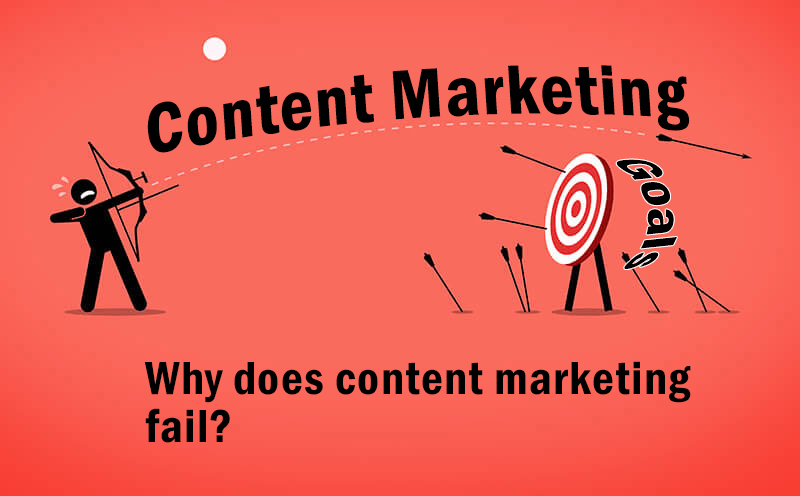What Are the Reasons Content Marketing Fails?
Content marketing is a powerful strategy that helps businesses attract, engage, and convert their audience. However, despite its potential, many campaigns fail to deliver meaningful results. The reasons behind these failures often stem from strategic misalignment, poor execution, or unrealistic expectations.

Understanding these pitfalls can help businesses refine their approach and create impactful content that resonates with their audience.
Lack of a Clear Strategy
A common reason content marketing fails is the absence of a well-defined strategy. Many businesses produce content without a structured plan, leading to inconsistent messaging and ineffective campaigns.
A strong content marketing strategy should align with business goals, define target audiences, and include a content calendar for consistent publishing. Without a clear direction, content efforts become fragmented and fail to drive engagement.
Targeting the Wrong Audience
Creating content without a deep understanding of the audience often leads to low engagement and poor conversion rates. Businesses sometimes assume they know their audience but fail to conduct proper research. Using data-driven insights, such as audience demographics, behavior patterns, and pain points, helps customize content that genuinely resonates with potential customers.
How to Fix It:
- Conduct in-depth market research to understand audience preferences.
- Use analytics tools to track user behavior and engagement metrics.
- Develop customer personas to guide content creation.
Poor Content Quality
Low-quality content is one of the fastest ways to lose credibility. Content that lacks depth, originality, or relevance fails to capture audience interest. Google’s algorithms prioritize high-quality, valuable content, making it essential for businesses to invest in well-researched and engaging material.
Key Elements of High-Quality Content:
- Well-researched information supported by credible sources.
- Clear, concise, and engaging writing.
- Visually appealing formatting with images, videos, or infographics.
Ignoring SEO Best Practices
Even the best content can go unnoticed if it isn’t optimized for search engines. Many businesses fail to implement effective SEO strategies, leading to poor visibility on search engines like Google. Keyword stuffing, ignoring metadata, and lacking internal linking can all hinder content performance.
SEO Best Practices
Using relevant long-tail keywords naturally within content improves search rankings and ensures alignment with user intent. Well-structured articles should include optimized meta titles, descriptions, and header tags to enhance visibility on search engines. Maintaining short paragraphs and clear subheadings improves readability, keeping readers engaged.

Additionally, securing backlinks from authoritative sources strengthens the credibility and boosts domain authority, making content more trustworthy and impactful.
Inconsistent Publishing Schedule
Content marketing requires consistency. Posting sporadically or failing to maintain a regular schedule reduces audience engagement. A well-structured content calendar ensures consistent posting, keeping the brand top-of-mind for users.
How to Stay Consistent:
- Plan content at least a month in advance.
- Use automation tools to schedule posts.
- Repurpose existing content into different formats to maximize reach.
Over-promotion instead of Value Creation
Many businesses treat content marketing as an advertising platform, leading to excessive self-promotion. Audiences seek value-driven content that educates, informs, or entertains rather than constant sales pitches. Content should focus on solving problems, offering insights, and building trust.
Balancing Promotion and Value:
- Follow the 80/20 rule: 80% valuable content, 20% promotional.
- Share case studies, success stories, and expert insights instead of direct ads.
- Engage in storytelling to connect with the audience emotionally.
Weak Distribution and Promotion
Creating great content isn’t enough, it needs the right promotion strategy. Many businesses fail because they rely solely on organic reach without leveraging multiple distribution channels. Effective content promotion involves a mix of social media, email marketing, paid ads, and influencer collaborations.
Effective Content Distribution Strategies
To ensure content reaches the right audience, sharing it across relevant social media platforms enhances visibility and engagement. Actively participating in online communities and forums help build credibility and attract organic traffic.
Additionally, investing in paid promotion expands reach, allowing businesses to target specific demographics and maximize content impact.
Not Measuring Performance and Adapting
Without tracking key performance metrics, businesses cannot identify what works and what doesn’t. Many content marketing efforts fail due to a lack of data-driven decision-making. Regularly analyzing performance helps refine strategies and improve future content.
Key Metrics to Track:
- Website traffic and engagement rates.
- Conversion rates and lead generation metrics.
- Bounce rates and time spent on the page.
Failing to Update and Repurpose Old Content
Content that becomes outdated loses its effectiveness. Many businesses create content but never revisit it for updates. Refreshing old content keeps it relevant and extends its lifespan. Companies that update old content see a 106% increase in traffic.
How to Keep Content Fresh
Regularly updating statistics and outdated information ensures content remains accurate and valuable to readers. Transforming existing articles into videos, podcasts, or infographics helps reach a broader audience through different formats.

Additionally, optimizing older content with new keywords improves search rankings, keeping it competitive in evolving digital spaces
Lack of Patience and Unrealistic Expectations
Content marketing is a long-term strategy, but many businesses expect instant results. When they don’t see immediate ROI, they abandon their efforts. Successful content marketing requires consistency, patience, and continuous improvement.
How to Stay Committed
Establishing realistic, measurable goals helps track progress and refine strategies for better results. Recognizing that content marketing builds trust over time ensures consistency and audience engagement. Prioritizing long-term value over quick wins leads to sustained growth, stronger brand authority, and higher conversion rates.
Final Thoughts
Content marketing fails without a strategy, audience alignment, and adaptability. Success comes from consistent publishing, value-driven messaging, and data-backed optimization. Brands that refine their approach, embrace SEO and focus on long-term growth turn efforts into measurable success.






